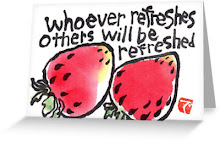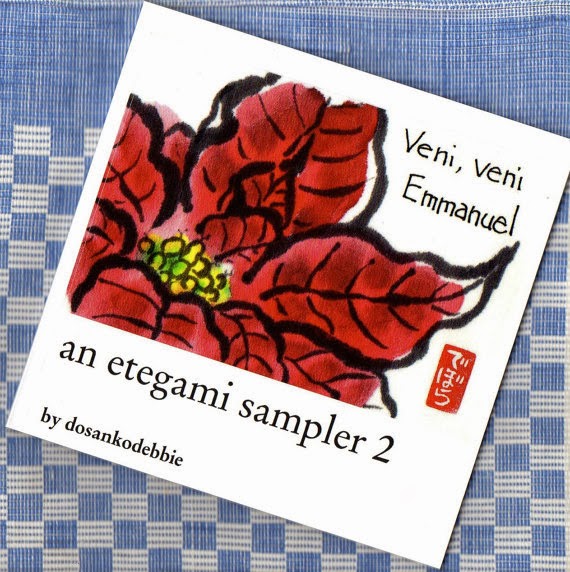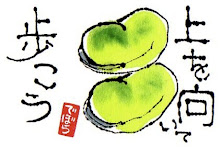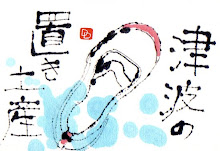
It's been a while since I posted a traditional etegami, so I thought it was time to review the basics. Etegami has very few rules, but there are certain characteristics that combine to make it what it is, and not some other kind of art.
Traditional etegami is: (1) hand-drawn artwork accompanied by hand-drawn words on postcards, and (2) usually depicts subjects from everyday life, especially those that reflect the changing of the seasons.
The equipment for traditional etegami usually includes: (1) absorbent washi postcards (2) ink brushes of various lengths and thickness (3) sumi ink (4) gansai paints (5) a name seal to affix to the work when it's finished.
The method for traditional etegami usually involves: (1) "living lines"~the wobbly, blotchy lines of inconsistent thickness that result from very, very slow strokes of the ink brush when forming the outline of the subject (2) a brief session of "living lines practice" every time you sit down to make etegami (3) "laying" the color on the card, rather than making strokes, and letting it spread naturally according to the character of the washi paper used (4) a limited selection of colors for each work, making the colors darker or lighter by judicious use of water, rather than by mixing different colors together (5) leaving areas of the drawing uncolored, rather than completely filling it in.
Having listed all these characteristics, I should say that etegami can be done on any kind of paper with any kind of tools, and if you use a paint brush on non-absorbent paper, you will have to use strokes to color it. Many etegami artists paint scenery, especially as a kind of picture-diary when they travel. But it isn't etegami without the addition of words. And it isn't really etegami unless it is meant to be posted to someone, or is at least in a form that can be posted at any time. Digital artwork accompanied by words and emailed to someone could be called etegami, as nontraditional as that form is. And you've seen my recent attempts to turn collage art into another nontraditional form of etegami.
The autumn-themed etegami I posted above depicts a kabocha, or Japanese pumpkin. And the accompanying words say exactly that: Japanese Kabocha. No humor, poetry, or delicate nuances on this one.






























I truly love this art! You know one of my books is called "Zen in the Kitchen" and my ex-boy friend made the drawings in sumie style. That book is my favorite with it's personal drawings (I wrote you through PC as well.)
ReplyDeleteTijen, I replied to your recipe card invitation through PC. It's a great idea, and actually I have done it once or twice. I think it would be a great topic to blog about here too. You've given me a great idea. Thanks!
ReplyDelete